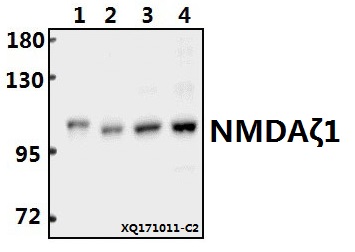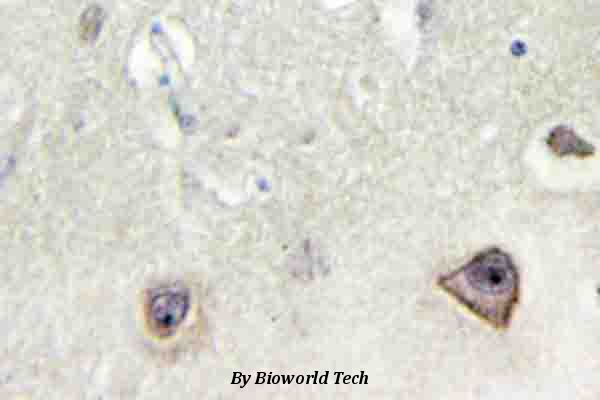Product Name :
NMDAζ1 (F891) polyclonal antibody Background :
NMDA receptor subtype of glutamate-gated ion channels possesses high calcium permeability and voltage-dependent sensitivity to magnesium. Mediated by glycine. Plays a key role in synaptic plasticity, synaptogenesis, excitotoxicity, memory acquisition and learning. It mediates neuronal functions in glutamate neurotransmission. Is involved in the cell surface targeting of NMDA receptors. The ion channels activated by glutamate are divided into two classes. Those that are sensitive to N-methyl-D-aspartate (NMDA) are designated NMDA receptors (NMDAR) while those activated by kainate and a-amino-3-hydroxy-5-methyl-4-isoxalone propionic acid (AMPA) are known as kainate/AMPA receptors (K/AMPAR). NMDA receptors are among the most studied receptors in neuroscience because they are involved in neuronal cell development and plasticity, a cellular correlate for learning. Product :
Rabbit IgG, 1mg/ml in PBS with 0.02% sodium azide, 50% glycerol, pH7.2 Storage&Stability :
Store at 4°C short term. Aliquot and store at -20°C long term. Avoid freeze-thaw cycles. Specificity :
NMDAζ1 (F891) polyclonal antibody detects endogenous levels of NMDAζ1 protein. Immunogen :
Synthetic peptide, corresponding to amino acids 860-910 of Human NMDAζ1. Conjugate :
Unconjugated Modification :
Unmodification
NMDAζ1 (F891) polyclonal antibody Background :
NMDA receptor subtype of glutamate-gated ion channels possesses high calcium permeability and voltage-dependent sensitivity to magnesium. Mediated by glycine. Plays a key role in synaptic plasticity, synaptogenesis, excitotoxicity, memory acquisition and learning. It mediates neuronal functions in glutamate neurotransmission. Is involved in the cell surface targeting of NMDA receptors. The ion channels activated by glutamate are divided into two classes. Those that are sensitive to N-methyl-D-aspartate (NMDA) are designated NMDA receptors (NMDAR) while those activated by kainate and a-amino-3-hydroxy-5-methyl-4-isoxalone propionic acid (AMPA) are known as kainate/AMPA receptors (K/AMPAR). NMDA receptors are among the most studied receptors in neuroscience because they are involved in neuronal cell development and plasticity, a cellular correlate for learning. Product :
Rabbit IgG, 1mg/ml in PBS with 0.02% sodium azide, 50% glycerol, pH7.2 Storage&Stability :
Store at 4°C short term. Aliquot and store at -20°C long term. Avoid freeze-thaw cycles. Specificity :
NMDAζ1 (F891) polyclonal antibody detects endogenous levels of NMDAζ1 protein. Immunogen :
Synthetic peptide, corresponding to amino acids 860-910 of Human NMDAζ1. Conjugate :
Unconjugated Modification :
Unmodification
-
 Western blot (WB) analysis of NMDAζ1 (F891) pAb at 1:500 dilution Lane1:MCF-7 whole cell lysate(20ug) Lane2:Hela whole cell lysate(40ug) Lane3:PMVEC whole cell lysate(40ug) Lane4:AML-12 whole cell lysate(40ug)
Western blot (WB) analysis of NMDAζ1 (F891) pAb at 1:500 dilution Lane1:MCF-7 whole cell lysate(20ug) Lane2:Hela whole cell lysate(40ug) Lane3:PMVEC whole cell lysate(40ug) Lane4:AML-12 whole cell lysate(40ug) -
 Immunohistochemistry (IHC) analyzes of NMDAζ1 (F891) pAb in paraffin-embedded human brain tissue.
Immunohistochemistry (IHC) analyzes of NMDAζ1 (F891) pAb in paraffin-embedded human brain tissue.
Bioworld Biotech only provide peptides for our antibodies and do not provide additional peptide customization services.
Price/Size :
USD 368/1mg/vial
Tips:
For phospho antibody, we provide phospho peptide(0.5mg) and non-phospho peptide(0.5mg).Describe :
Blocking peptides are peptides that bind specifically to the target antibody and block antibody binding. These peptide usually contains the epitope recognized by the antibody. Antibodies bound to the blocking peptide no longer bind to the epitope on the target protein. This mechanism is useful when non-specific binding is an issue, for example, in Western blotting (WB) and Immunohistochemistry (IHC). By comparing the staining from the blocked antibody versus the antibody alone, one can see which staining is specific; Specific binding will be absent from the western blot or IHC performed with the neutralized antibody.Formula:
Synthetic peptide was lyophilized with 100% acetonitrile and is supplied as a powder. Reconstitute with 0.1 ml DI water for a final concentration of 10 mg/ml.The purity is >90%,tested by HPLC and MS.
Storage:
The freeze-dried powder is more stable. For short time at 2-8°C. For long term storage store at -20°C.
Note :
This product is for research use only (RUO only). Not for use in diagnostic or therapeutic procedures.
 NMDAζ1 (F891) polyclonal antibody
NMDAζ1 (F891) polyclonal antibody  Datasheet
Datasheet COA
COA MSDS
MSDS SHIP
SHIP